Norwalk Yesterday & Today
The Norwalk of Yesterday
Originally, the land that became known as “Norwalk” was home to the Shoshonean Indian tribes. They survived primarily on honey, an array of berries, acorns, sage, squirrels, rabbits and birds. Their huts were part of the Sejat Indian village.
In the late 1760s, Spanish settlers, Padres and missions flourished in the area. In 1833, the Mexican government passed the Secularization Bill, which returned the land to the Indian tribes. However, the Indian tribes suffered the loss of much of their culture, and were unable to successfully cope with the return of their land.

The Rancho and mining days in California ended around the 1860’s and the land was subdivided once again and made available for sale. Word of this land development reached the Sproul Brothers in Oregon. They recalled the fertile land and huge sycamore trees they saw during an earlier visit to the Southern California area. In 1869, Atwood Sproul, on behalf of his brother, Gilbert, purchased 463 acres of land at $11 an acre in an area known as Corazon de los Valles, or “Heart of the Valleys.”

By 1873, news of a railroad service coming through the area was committed. The Sprouls deeded 23 acres and stipulated a “passenger stop” clause in the deed. Three days after the Anaheim Branch Railroad crossed the “North-walk” for the first time, Gilbert Sproul surveyed a town site. In 1874, the name was recorded officially as Norwalk. The Museum is open on the first Sunday of the month from 1:00 – 3:00 p.m. Tours for groups of 10 or more are also available by appointment. Please call (562) 929-5702 for more information.
While a majority of the Norwalk countryside remained undeveloped during the 1880’s, the Norwalk Station allowed potential residents the opportunity to visit the “country” from across the nation. This pre-1900 era also brought the “first families” to Norwalk, including the Sprouls, the Dewitts, the Settles, the Orrs, and many others. They grouped together to shape the future of this community.
In 1880, D.D. Johnston pioneered the first school system in Norwalk. Johnston was also responsible for the first real industry in town, a cheese factory, by furnishing Tom Lumbard with the money in 1882.
Norwalk celebrated the famous “Gay 90s” with the construction of a number of fine homes that were located in the middle of orchards, farms and dairies. One of those residential landmarks was built in 1891 by the D. D. Johnston family, and it subsequently became known as the Hargitt House, an 1891 Victorian Eastlake. Today, you have the opportunity of visiting the Hargitt House Museum, located at 12426 Mapledale, which was donated to the people of Norwalk by Charles (“Chun”) and Ida Hargitt. The Museum is open on the first and third Saturdays of the month from 1:00 p.m. to 4:00 p.m. Tours for groups of 10 or more area also available by request. Please call (562) 929-5702 for more information. On the day of your visit, please call the Museum directly after 12 noon at (562) 929-5612 if you have any questions.

At the turn of the century, Norwalk had become established as the dairy “Heart of the Valleys.” Of the 50 local families reported in the 1900 census, most were associated with farming or with the dairy industry. Norwalk was also the home of some of the largest sugar beet farms in all of Southern California during this era. As the years passed, the community continued to grow. Permanent educational facilities were constructed, electricity and telephone service installed, and railroads and highways linked Norwalk to statewide markets.
The need for local control over local affairs soon became so great that a special incorporation election was called. On August 26, 1957, Norwalk was certified by the Secretary of State as California’s 15th largest city and became L.A. County’s 66th city. With cityhood came startling improvements in services to local residents. Progressive health and building standards were adopted, law enforcement increased, storm drainage improved, and citywide street lighting districts formed.
The Norwalk of Today
The City of Norwalk was incorporated on August 26, 1957 becoming Los Angeles County’s 66th City. Comprising about 9.77 square miles, the City has continued to grow and develop into a prosperous and culturally rich community of over 109,000 residents.

Located at the midpoint between Los Angeles and Orange Counties, Norwalk is just minutesaway from the finest cultural, educational and entertainment centers both counties have to offer. Mountains and beaches are also close and readily accessible. In 2007, the City of Norwalk will proudly celebrate its 50th Anniversary with a community sense of pride and accomplishment anticipating an even brighter future.
Norwalk is a general law city, and contracts for services in law enforcement and fire with the Los Angeles County Sheriff’s Department. The City also contracts out for water, street sweeping, and trash disposal. In business, education, government, and law enforcement, the signs of growth serve as evidence for a bright future.

Norwalk’s parks and community recreation programs are administered by the City’s Recreation and Park Services Department. The parks system consists of 12 parks with a total of 87.3 acres of land. An additional asset to the City is, of course, its location. Norwalk sits at the heart of an expanding regional transportation network; an outstanding convenience to residents that work anywhere in Los Angeles or Orange Counties.